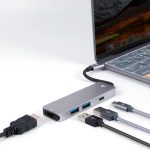If you're setting up multiple monitors, USB hubs are your best friend. They expand your connectivity options, allowing you to connect several devices through a single USB port. You'll enjoy faster data transfer and keep your workspace organized, reducing cable clutter. Look for hubs with plenty of ports, power delivery capabilities, and compatibility with your devices. Choosing the right hub maximizes productivity and streamlines your setup. Explore more to discover the best options for your multi-monitor needs.
Table of Contents
Key Takeaways
- USB hubs expand connectivity options for multiple monitors, allowing seamless multitasking and efficient workspace organization.
- Look for USB 3.0 hubs for high-speed data transfer, essential for high-resolution displays.
- Powered USB hubs ensure sufficient power for multiple displays and keep devices charged while working.
- Consider USB-C multiport adapters for versatile connectivity, accommodating various devices and monitor types.
- Optimize your monitor setup ergonomically and maintain consistent resolution for a smoother user experience.
Understanding USB Hubs and Their Importance
USB hubs are essential tools that expand your connectivity options, especially when you want to set up multiple monitors. They allow you to connect several devices to your computer through a single USB port, enabling a more organized workspace.
When you're juggling tasks across various screens, having a USB hub means you can easily plug in peripherals like keyboards, mice, and external drives without hassle. You'll appreciate the flexibility it offers, letting you customize your setup based on your needs.
Plus, many hubs support high-speed data transfer, which is vital for smooth performance. By incorporating a USB hub into your setup, you'll ensure a seamless and efficient multi-monitor experience that enhances productivity.
Key Features to Consider When Choosing a USB Hub
When setting up multiple monitors, not all USB hubs are created equal. First, check the hub's data transfer speed; a USB 3.0 hub is ideal for high-resolution displays.
Next, consider the number of ports. You'll want enough to connect all your devices without needing to swap cables constantly.
Also, look for hubs with power delivery capabilities, which can keep your devices charged while you work.
Compatibility matters too; ensure the hub works with your operating system and monitor types.
Finally, think about build quality and design. A compact, sturdy hub can make a significant difference in your workspace.
Benefits of Using USB Hubs for Multiple Monitors
Having a reliable USB hub can significantly enhance your experience with multiple monitors, as it streamlines your setup and maximizes productivity.
With a USB hub, you can easily connect all your devices without cluttering your workspace with cables. It allows for seamless switching between monitors, making multitasking a breeze.
You'll find that transferring files between devices becomes quicker and more efficient, saving you valuable time. Plus, many hubs offer additional ports for charging devices, which means you can keep everything powered up without hassle.
Types of USB Hubs Suitable for Multi-Monitor Setups
When setting up multiple monitors, it's crucial to choose the right type of USB hub.
Powered USB hubs can provide the necessary power for all your devices, while USB-C multiport adapters offer versatile connectivity options.
Additionally, DisplayLink technology can enhance your setup by allowing multiple monitors to connect seamlessly.
Powered USB Hubs
A powered USB hub can be a game-changer for multi-monitor setups, providing the necessary power and connectivity to support multiple displays.
When you connect several monitors to your computer, you might find that standard USB hubs can't deliver enough power, leading to performance issues.
With a powered USB hub, you'll enjoy reliable connections and sufficient power for all your devices. These hubs often come with additional ports, allowing you to connect peripherals like keyboards and mice without sacrificing your monitor connections.
Look for hubs with USB 3.0 or higher speeds to ensure optimal performance.
Investing in a quality powered hub means you can seamlessly manage your multi-monitor setup, enhancing your productivity and efficiency.
USB-C Multiport Adapters
USB-C multiport adapters are essential for anyone looking to expand their multi-monitor setup without hassle. They provide various ports to connect multiple displays, ensuring you stay productive and organized. Here's a quick comparison of some popular options:
| Adapter Type | Number of Displays |
|---|---|
| Basic Adapter | 1 |
| Dual HDMI Adapter | 2 |
| Triple Display Hub | 3 |
| 4K Multiport Hub | 4 |
With these adapters, you can easily connect monitors for work, gaming, or streaming. Just plug them into your USB-C port, and you're ready to go. Choosing the right adapter will help you maximize your screen space and enhance your overall experience.
DisplayLink Technology Options
DisplayLink technology offers several USB hub options that are perfect for multi-monitor setups. These hubs allow you to connect multiple displays using a single USB port, giving you the flexibility you need.
You can choose from a variety of DisplayLink-enabled docking stations or USB hubs, which provide multiple video outputs like HDMI, DisplayPort, or even VGA. When selecting a hub, look for one that supports the resolution and refresh rates you desire.
Also, ensure it's compatible with your operating system, whether you're using Windows, macOS, or Linux. With the right DisplayLink hub, you'll enhance your productivity and streamline your workspace, making it easier to manage multiple applications across different screens.
Top Recommendations for USB Hubs for Multiple Monitors
When you're looking to expand your workspace with multiple monitors, choosing the right USB hub can make all the difference.
For seamless connectivity, consider the Anker 10-Port USB 3.0 Hub. It offers ample ports and fast data transfer.
If you need DisplayLink support, the Plugable USB 3.0 to HDMI/DVI Adapter is a solid choice, allowing you to connect multiple displays effortlessly.
Another great option is the Sabrent 4-Port USB 3.0 Hub with individual power switches, giving you better control over your devices.
Lastly, the Orico 4-Port USB 3.0 Hub is compact and portable, perfect for on-the-go use.
With these recommendations, you'll set up an efficient multi-monitor environment that enhances your productivity.
Tips for Optimizing Your Multi-Monitor Setup
Setting up multiple monitors can significantly boost your productivity, but optimizing that setup is key to reaping the full benefits.
First, arrange your monitors ergonomically; position them at eye level to reduce strain. Use the same resolution across all displays for a seamless experience, and adjust scaling settings if necessary.
Arrange monitors at eye level for comfort and use consistent resolution for a seamless multitasking experience.
Don't forget to customize your display settings in your operating system to ensure windows snap easily between screens. Utilize keyboard shortcuts to enhance navigation, making multitasking smoother.
Invest in a quality USB hub for reliable connections and to reduce cable clutter.
Lastly, keep your workspace organized and distraction-free so you can focus on your tasks without unnecessary interruptions.
Optimize these elements to maximize your multi-monitor efficiency!
Frequently Asked Questions
Can USB Hubs Support 4K Resolution for Multiple Monitors?
Yes, USB hubs can support 4K resolution for multiple monitors, but you'll need to ensure they're high-quality and specifically designed for that purpose. Always check the specifications to guarantee optimal performance for your setup.
How Many Monitors Can a Single USB Hub Connect?
A single USB hub can typically connect two to four monitors, depending on its specifications and output capabilities. You'll need to check the hub's details to ensure it meets your desired setup requirements.
Do USB Hubs Require External Power for Multiple Monitors?
USB hubs don't always require external power for multiple monitors, but it depends on the hub's design and the monitors' power needs. You should check the specifications to ensure proper functionality without external power.
Are There Compatibility Issues With Different Operating Systems?
Yes, there can be compatibility issues with different operating systems. You'll want to check if your USB hub supports your OS and ensure drivers are up to date to avoid potential connectivity problems.
Can a USB Hub Improve Monitor Refresh Rates?
A USB hub itself won't directly improve monitor refresh rates. However, it can enhance connectivity and organization, allowing you to use multiple monitors effectively. Make sure your devices and cables support the desired refresh rates for optimal performance.




